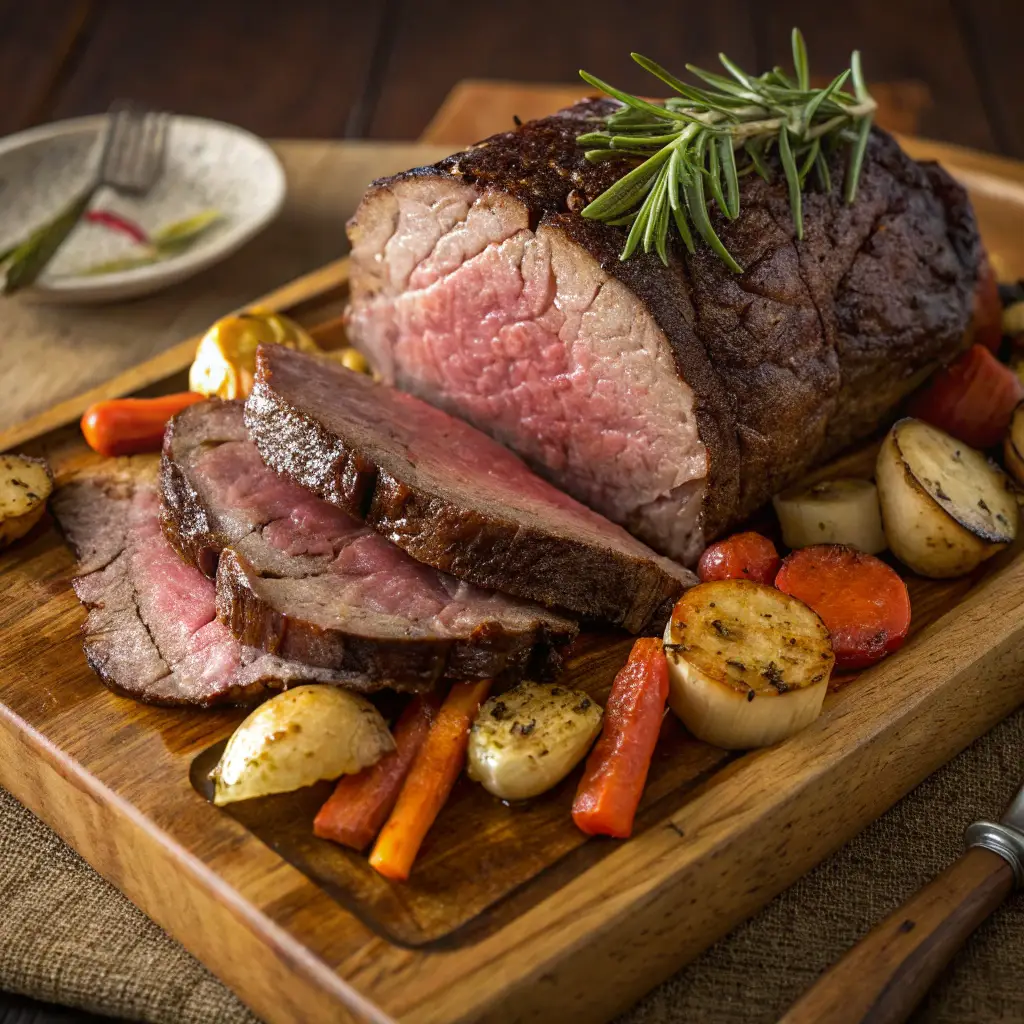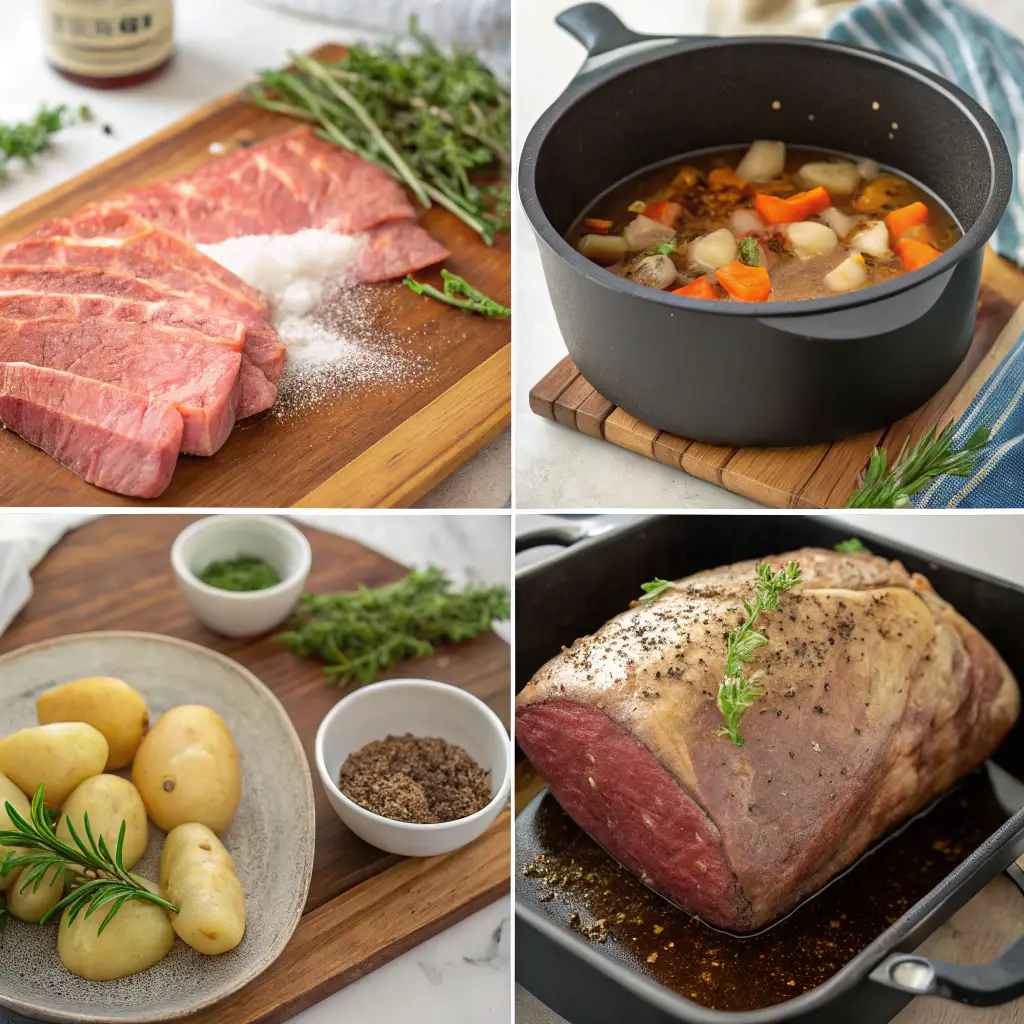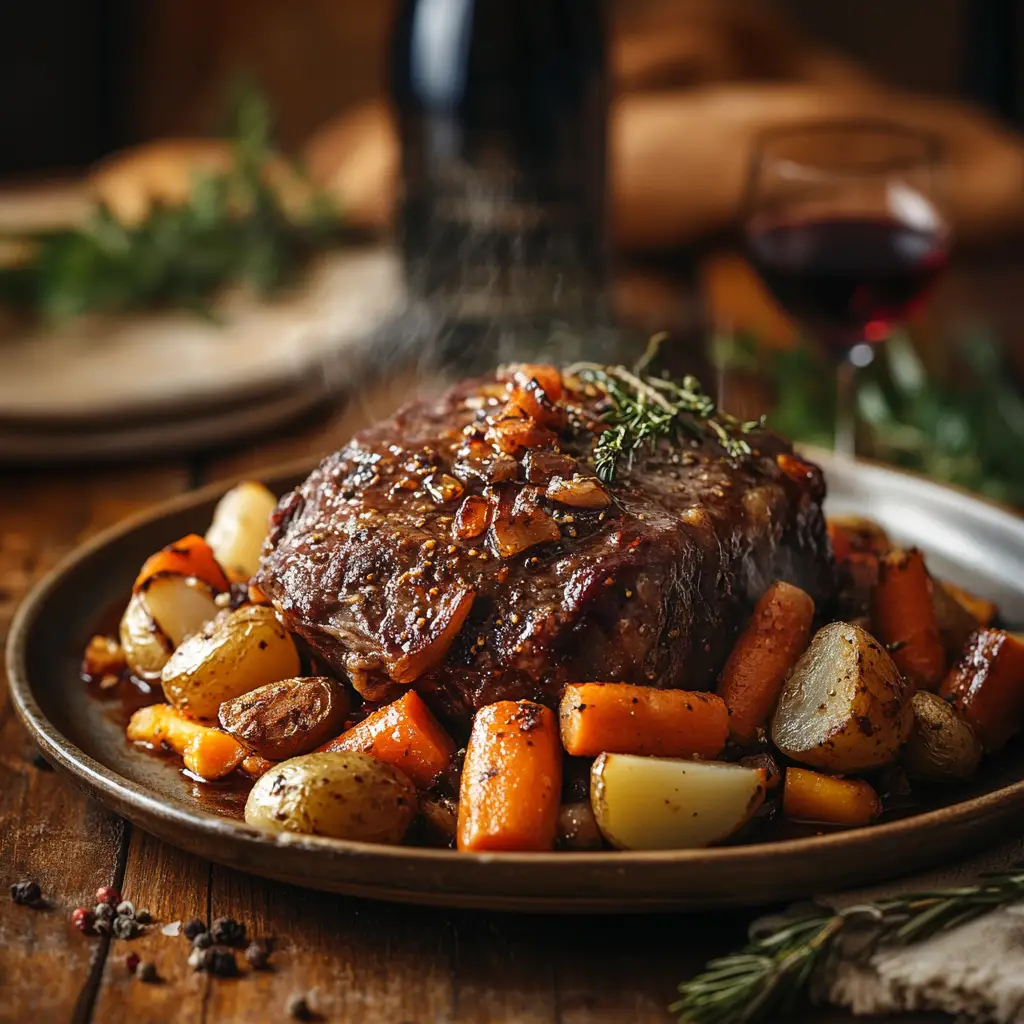Craving a hearty and satisfying dish? Look no further than this Beef Arm Roast Recipe, a foolproof way to create a tender, flavorful roast that will impress any crowd. Known for its melt-in-your-mouth texture and rich taste, a beef arm roast is the ultimate choice for cozy family dinners, festive occasions, or simple yet comforting meals. In this guide, we’ll show you everything you need to know to perfect this classic recipe, from selecting the best cut of beef to mastering cooking techniques. Read on to discover how to make a beef arm roast that will become a household favorite.
This article covers everything you need to know, from selecting the right ingredients to mastering cooking methods that enhance the natural taste of the beef. With a few simple tips, you’ll discover how to achieve a perfectly cooked roast every time. Keep reading to learn how to create a beef arm roast recipe that will quickly become a household favorite.
Table of Contents
Ingredients Needed in beef arm roast recipe

The success of any beef arm roast recipe starts with the right ingredients. Choosing high-quality components ensures your dish will be flavorful and satisfying. Below is a list of essentials you’ll need:
- Beef arm roast: Aim for a 3-4 pound cut with good marbling.
- Vegetables: Carrots, onions, potatoes, and celery are classic choices.
- Seasonings: Salt, black pepper, garlic powder, and onion powder.
- Herbs: Rosemary and thyme for aromatic depth.
- Liquid: Beef broth or red wine to keep the roast moist during cooking.
- Oil or butter: For searing the roast and enhancing the flavor.
Fresh and well-balanced ingredients are the foundation of any great beef arm roast recipe. Consider sourcing your produce locally or selecting organic options for the best results.
Kitchen Tools Required
To execute a flawless beef arm roast recipe, having the right kitchen tools is just as important as the ingredients. Here’s a checklist to ensure you’re fully equipped:
- Dutch oven or roasting pan: Essential for even heat distribution.
- Meat thermometer: For accurate temperature readings.
- Sharp knife: For trimming and slicing the roast.
- Cutting board: A sturdy surface for prepping your ingredients.
- Tongs or spatula: Useful for handling the roast during searing.
- Mixing bowls: For combining seasonings and preparing vegetables.
- Aluminum foil: To cover the roast while it rests.
Having these tools on hand not only simplifies the cooking process but also ensures your beef arm roast recipe is prepared with precision and care.
Step-by-Step Preparation beef arm roast recipe
Preparing a beef arm roast recipe may seem daunting, but breaking it down into manageable steps makes it approachable. Follow this guide for the best results:

- Trim the roast: Remove excess fat, leaving a thin layer for flavor.
- Season generously: Rub the roast with a mix of salt, pepper, garlic powder, and onion powder.
- Prepare vegetables: Chop carrots, onions, potatoes, and celery into uniform sizes.
- Sear the roast: Heat oil or butter in a Dutch oven and brown the roast on all sides.
- Deglaze the pan: Add a splash of beef broth or red wine to lift flavorful bits.
- Assemble in the pan: Place the roast in the center and surround it with vegetables and herbs.
- Add liquid: Pour enough broth or wine to cover the bottom of the pan.
- Cover and cook: Bake in a preheated oven at 325°F for 2.5–3 hours, checking periodically.
This detailed process ensures your beef arm roast recipe comes out tender and full of flavor.
Cooking Methods for a Perfect Beef Arm Roast Recipe
There are several methods to cook a beef arm roast recipe, depending on your preferences and available equipment. Here are three popular approaches:
1. Oven Roasting
- Preheat your oven to 325°F.
- Use a covered roasting pan or Dutch oven.
- Roast for 2.5–3 hours, turning once halfway through.
2. Slow Cooker
- Add seasoned roast and vegetables to the slow cooker.
- Cook on low for 8 hours or high for 4-5 hours.
- Ensure enough liquid covers the bottom of the cooker.
3. Pressure Cooker
- Brown the roast using the sauté function.
- Add vegetables and liquid, then cook on high pressure for 60-75 minutes.
- Allow natural pressure release for tender results.
Each method offers a unique way to prepare your beef arm roast recipe, but all ensure a delicious outcome.
If you enjoy beef-based dishes and are looking for a quick and flavorful alternative to a traditional roast, consider trying the Yoshinoya Beef Bowl Recipe. Inspired by the famous Japanese fast-food chain, this dish features thinly sliced beef simmered in a savory-sweet sauce, served over a bed of steaming rice. It’s an excellent option when you’re craving a hearty yet simple meal, with a delicious umami-packed flavor. You can find the full Yoshinoya Beef Bowl Recipe here to explore a different take on beef preparation.
Tips for the Best Results for a Perfect Beef Arm Roast Recipe
To make your beef arm roast recipe truly exceptional, keep these tips in mind:
- Choose quality meat: Look for cuts with even marbling.
- Don’t rush searing: Browning locks in flavors and creates a rich crust.
- Use a thermometer: The roast is done when the internal temperature reaches 145°F.
- Let it rest: Allow the meat to rest under foil for 15 minutes before slicing.
- Deglaze effectively: Use wine or broth to capture all the flavors from the pan.
By following these tips, your beef arm roast recipe will consistently deliver outstanding results.
Flavor Variations for beef arm roast recipe
Adding variety to your beef arm roast recipe keeps the dish exciting and versatile. Here are some flavor twists to try:
- Italian-inspired: Use Italian seasoning, tomatoes, and garlic-infused olive oil.
- Spicy kick: Incorporate chili powder, smoked paprika, and cayenne.
- Herb-forward: Swap rosemary and thyme for sage and oregano.
- Asian flair: Add soy sauce, ginger, and sesame oil to the broth.
- Sweet and savory: Include brown sugar, apple cider, and cinnamon.
Each variation brings a distinct taste profile to your beef arm roast recipe, ensuring there’s something for every palate.
If you’re looking for another tender and flavorful beef roast option, you might enjoy trying the Mississippi Pot Roast Recipe. This dish takes a unique approach to slow-cooked beef, featuring ranch seasoning, pepperoncini peppers, and butter for a rich and tangy flavor. It’s an easy and delicious alternative to a traditional beef arm roast recipe, especially if you love bold, Southern-inspired flavors. You can check out the full Mississippi Pot Roast Recipe to add a new twist to your roast repertoire.
Pairing Suggestions for a beef arm roast recipe
A perfectly cooked beef arm roast recipe deserves equally impressive side dishes and beverages to create a harmonious meal. Here are some pairing ideas to elevate your dining experience:
- Classic Sides: Mashed potatoes, roasted Brussels sprouts, or green beans complement the hearty flavors of the roast.
- Grains: Serve with wild rice or buttery egg noodles to soak up the flavorful juices.
- Salads: A crisp Caesar salad or a tangy coleslaw adds freshness to balance the richness of the roast.
- Beverages: Pair with a robust red wine like Cabernet Sauvignon, a dark ale, or even a bold iced tea.
These pairings enhance the overall experience, ensuring your beef arm roast recipe becomes a centerpiece for a memorable meal.
Storing and Reheating
Properly storing and reheating your beef arm roast recipe ensures the flavors and textures are preserved. Follow these simple steps to keep your leftovers fresh:
- Storage:
- Allow the roast to cool to room temperature before storing.
- Place it in an airtight container or wrap it tightly in aluminum foil.
- Store in the refrigerator for up to 4 days or in the freezer for up to 3 months.
- Reheating:
- For the oven: Preheat to 300°F, cover the roast with foil, and heat for 20–30 minutes.
- For the stovetop: Simmer slices with a splash of broth in a covered skillet until warm.
- For the microwave: Use low heat settings and cover to retain moisture.
By following these methods, your beef arm roast recipe will retain its tenderness and flavor, even after reheating.
Nutritional Insights Beef Arm Roast Recipe
Understanding the nutritional profile of a beef arm roast recipe helps you make informed decisions for your meal planning. Here’s an overview:
- Protein-Rich: Each serving provides approximately 25–30 grams of high-quality protein.
- Moderate Calories: A typical serving contains about 250–300 calories, depending on portion size and preparation.
- Essential Nutrients: The roast is an excellent source of iron, zinc, and B vitamins, supporting energy and immune health.
- Low in Carbs: Ideal for low-carb or keto diets, as it contains minimal carbohydrates.
- Customizable: Adding vegetables and broth boosts fiber and nutrient content without significantly increasing calories.
By incorporating this beef arm roast recipe into a balanced diet, you can enjoy a flavorful meal while meeting your nutritional goals.
Troubleshooting Common Issues
Even the most seasoned cooks encounter challenges when preparing a beef arm roast recipe. Here are solutions to common problems:
- Tough Meat: Ensure you’re cooking low and slow. If the roast is still tough, extend the cooking time.
- Dry Roast: Add more liquid during cooking and use a covered pan to trap moisture.
- Lack of Flavor: Season generously and sear the meat thoroughly to build depth of flavor.
- Vegetables Too Soft: Add vegetables halfway through the cooking process instead of at the beginning.
- Burned Pan Drippings: Use enough liquid to prevent scorching and monitor the cooking temperature.
These tips will help you troubleshoot and perfect your beef arm roast recipe, ensuring consistent success.
Serving Suggestions about beef arm roast recipe
Serving your beef arm roast recipe with creativity and flair enhances the presentation and enjoyment of the meal. Here are some serving ideas to inspire you:
- Platter Presentation: Arrange slices of the roast on a large platter surrounded by colorful vegetables.
- Individual Portions: Plate each serving with a drizzle of pan juices and a sprig of fresh herbs for garnish.
- Family-Style: Place the roast in a Dutch oven and serve directly from the cooking vessel for a rustic touch.
- Leftover Ideas:
- Use shredded roast in sandwiches with horseradish sauce.
- Add to tacos or wraps with fresh toppings.
- Incorporate into soups or stews for a quick meal.
These suggestions ensure your beef arm roast recipe is served with style, making the meal even more enjoyable.
FAQs
What is a beef arm roast good for?
A beef arm roast is ideal for hearty, slow-cooked meals like pot roasts, stews, and shredded beef dishes. With its rich flavor and generous marbling, it’s perfect for recipes requiring low and slow cooking methods. Because it becomes tender with prolonged cooking, it’s a fantastic choice for feeding a crowd or preparing comforting dishes. Additionally, its versatility allows you to incorporate it into various cuisines, from traditional Sunday dinners to flavorful tacos.
What is the best way to cook arm steak?
The best way to cook an arm steak is by braising, as this method ensures it stays tender and juicy. First, sear the steak in a hot pan to lock in its flavor. Then, simmer it in a flavorful liquid like beef broth or red wine, ensuring the liquid covers the bottom of the pan. Cover and cook on low heat until the meat becomes tender, which usually takes 2–3 hours. Alternatively, you can use a slow cooker or pressure cooker for similar results. Both methods maximize flavor and texture while minimizing effort.
How do you tenderize an Arm Roast?
Tenderizing an arm roast starts with proper preparation. First, marinate the meat in an acidic mixture, such as vinegar, lemon juice, or buttermilk, for several hours to break down tough fibers. You can also use a meat mallet to physically tenderize the roast. Additionally, seasoning the roast with salt an hour before cooking helps draw out moisture, which enhances tenderness. Most importantly, cooking it low and slow—whether in a slow cooker, oven, or pressure cooker—allows the connective tissues to break down, resulting in a melt-in-your-mouth texture.
Which is more tender, Arm Roast or Rump Roast?
When comparing tenderness, the rump roast tends to be slightly more tender than the arm roast. This difference arises because the rump roast comes from a less active muscle group, while the arm roast is from a more heavily worked area of the cow. However, both cuts benefit from slow cooking, which enhances their tenderness. If you prioritize tenderness, the rump roast may edge ahead, but with the right cooking method, the beef arm roast recipe can be equally satisfying and flavorful.
Conclusion
Mastering a beef arm roast recipe is about more than just following instructions—it’s about creating a meal that brings people together. From selecting the right pairings to properly storing leftovers, every detail contributes to a memorable dining experience. With these tips and insights, you’re now equipped to handle every aspect of preparation and presentation with confidence.
Whether you’re serving this dish for a special occasion or as a comforting family meal, the beef arm roast recipe promises to deliver flavor, warmth, and satisfaction. Enjoy the journey of crafting a meal that’s sure to become a staple in your home!

